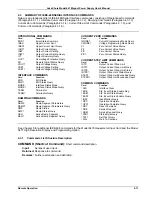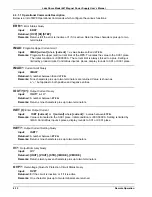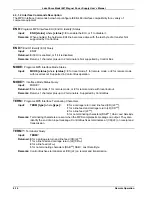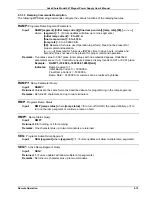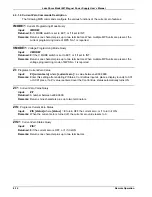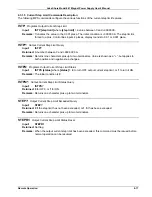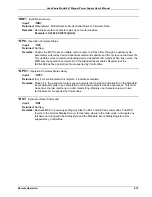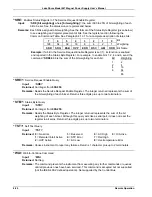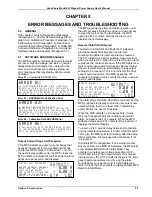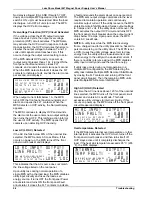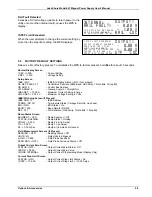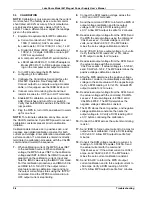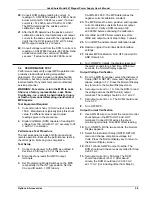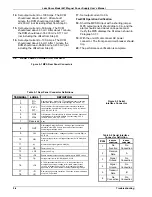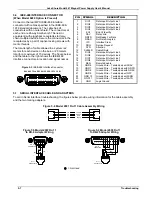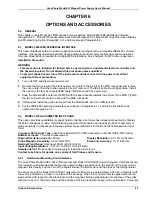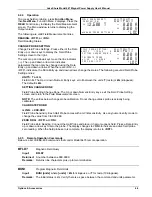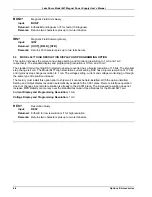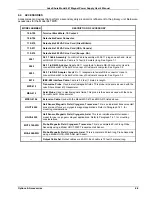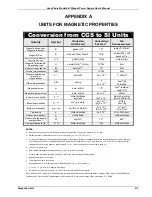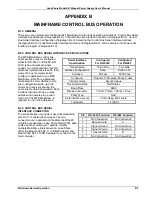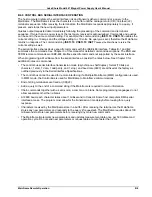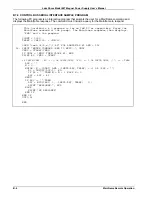
Lake Shore Model 647 Magnet Power Supply User’s Manual
Options & Accessories
5-5
20.
Convert DVM voltage reading to current. A
reading of +0.512345V 51.2345A. Send
actual current with ‘CALPL+xxx.xxxx’. If actual
current is +51.2345A, send ‘CALPL+51.2345’.
The MPS determines the positive current
calibration constant.
21.
After the MPS determines the positive current
calibration constant, it automatically sets output
current to the same value with the opposite sign.
Verify that the DVM reads -0.05V ±10%. Allow
MPS output to settle for 2 minutes.
22.
Convert voltage read from the DVM to current. A
reading of -0.0487655V equals -48.7655A. Send
actual current with the command ‘CALMN-
xxx.xxxx’. If actual current is 48.7655A, send
‘CALMN-48.7655’. The MPS determines the
negative current calibration constant.
23.
The MPS stores the zero, positive, and negative
current calibration constants then sets output
current to 0. Verify a DVM reading of 0V
±0.00005V before continuing the calibration.
24.
Use IMAX and STPS commands to restore
IMAX and output current step to Step 7 values.
25.
Turn off MPS and disconnect calibration loads.
26.
Restore original Control Bus Serial Interface
settings.
27.
Disable MPS calibration. Turn OFF (down) CAL
AND ID switch 8.
5.4 PERFORMANCE
TEST
Performance tests verify proper MPS operation into
a resistive load without testing all specified
parameters. The tests include no troubleshooting
information, but can provide information that may
localize faults. If any tests fail, contact authorized
service personnel.
WARNING: For service, return the MPS to Lake
Shore or a factory representative. Lake Shore
Cryotronics, Inc. cannot be held liable for injury
or death of personnel attempting unauthorized
MPS repairs.
Test Equipment Required
1.
Current monitor shunt, 100 mV output, rated at
150 A . Manufacturers typically stock this shunt
value. If a different value is used, adjust
readings given in the procedure.
2.
Digital Volt Meter (DVM) capable of reading DC
voltage from 100 mV with 0.1 mV accuracy to 35
V with 0.1 V resolution.
Performance Test Procedure
The test procedure includes both front panel and
remote operation. Execute the performance tests in
the order given. Note any non-compliance.
Test Setup
1.
Connect input power to the MPS as outlined in
Sections 2.5 through 2.5.3 of this manual.
2.
Disconnect any leads from MPS output
terminals.
3.
Set Programming Mode Switches on the MPS
rear panel(s) to the INT (up) position. Set the
CAL and ID switch 7 OFF (down).
4.
Turn ON MPS. Initially, the display clears and
the alarm sounds for a short time. Within two
seconds, the Normal Display appears.
Output Voltage Verification
5.
From the MPS front panel, select the Instrument
Setup (INSTR. SETUP) menu and change com-
pliance voltage to 5 V. Press the Normal Display
key to return to the Normal Display screen.
6.
Set output current to +1 A. Use the DVM to read
the voltage across the MPS unit(s) output
terminals. The reading should be +5 V ±0.3 V.
7.
Set output current to 1 A. The DVM should read
5 V ±0.3 V.
8.
Turn OFF MPS.
Output Current Verification
9.
Use AWG #4 wire to connect the current monitor
shunt between the MPS +OUT and -OUT
terminals. Connect DVM across the shunt
monitoring terminals. Note DVM offset reading.
10.
Turn ON MPS. Within two seconds, the Normal
Display appears.
11.
Select the Instrument Setup (INSTR. SETUP)
menu and change compliance voltage to 2
Volts. Press the Normal Display key to return to
the Normal Display screen.
12.
Wait 1 minute for MPS output to settle. The
DVM should read the same as recorded for Step
9 ±0.01 mV.
13.
Set output current to +50 Amps The DVM
should read about +33 mV. After about 1
minute, the DVM should read +33.333 mV
±0.117 mV (not including offset from Step 9).

